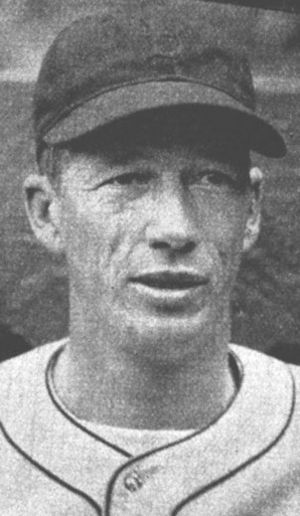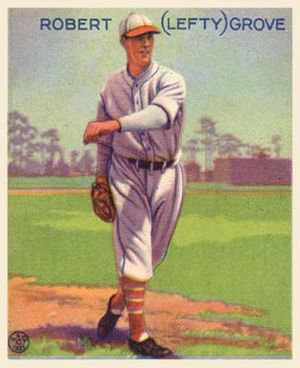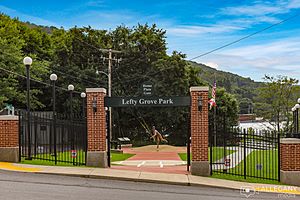Lefty Grove facts for kids
Quick facts for kids Lefty Grove |
|||
|---|---|---|---|

Grove in 1939
|
|||
| Pitcher | |||
| Born: March 6, 1900 Lonaconing, Maryland, U.S. |
|||
| Died: May 22, 1975 (aged 75) Norwalk, Ohio, U.S. |
|||
|
|||
| debut | |||
| April 14, 1925, for the Philadelphia Athletics | |||
| Last appearance | |||
| September 28, 1941, for the Boston Red Sox | |||
| MLB statistics | |||
| Win–loss record | 300–141 | ||
| Earned run average | 3.06 | ||
| Strikeouts | 2,266 | ||
| Teams | |||
|
|||
| Career highlights and awards | |||
|
|||
| Induction | 1947 | ||
| Vote | 76.4% (third ballot) | ||
Robert Moses "Lefty" Grove (born March 6, 1900 – died May 22, 1975) was an amazing American professional baseball pitcher. He was known for his powerful left-handed throws.
Lefty Grove started his career in the minor leagues in the early 1920s. He quickly became a huge star in Major League Baseball (MLB). He played for the Philadelphia Athletics and the Boston Red Sox. Many people consider him one of the best pitchers ever.
Grove led the American League in wins four times. He was the leader in strikeouts for seven years in a row! He also had the lowest earned run average (ERA) in the league a record nine times. From 1929 to 1931, he won the pitcher's Triple Crown twice. This means he led the league in wins, strikeouts, and ERA. During these years, he had an incredible record of 79 wins and only 15 losses. He also helped the Athletics win three straight American League championships.
Overall, Lefty Grove won 300 games during his 17-year MLB career. He was chosen for the National Baseball Hall of Fame in 1947.
Contents
Early Life and Baseball Start
Lefty Grove was born in Lonaconing, Maryland. He was one of eight children. His father and brothers worked in coal mining.
Grove played baseball in empty lots, called "sandlots," around the Baltimore area. He didn't play organized baseball until he was 19 years old. People say he learned to throw so hard by throwing rocks!
In 1920, he played his first professional game. He joined the Martinsburg Mountaineers in the class-D Blue Ridge League. He played in six games and pitched 59 innings pitched. He only allowed 30 hits and had a great earned run average (ERA) of 1.68.
His amazing pitching caught the eye of Jack Dunn, Sr.. Dunn was the manager and owner of the minor league Baltimore Orioles. Dunn was also the person who discovered baseball legend Babe Ruth. Dunn bought Grove's contract by giving Martinsburg enough money to replace their outfield wall!
Baltimore Orioles (Minor League)
Grove joined the Baltimore Orioles in 1920. At that time, the Orioles were a very successful minor league team. They played in the International League. Grove quickly became a key pitcher for the team. He had a 12–2 record for the rest of that season.
The Orioles were on a winning streak, taking six straight International League titles from 1919 to 1925. Over the next four seasons, Grove continued to shine. He had records like 25–10, 18–8, 27–10, and 26–6. He led the International League in strikeouts every single one of those years.
Grove stayed in the minor leagues until 1924. His owner, Jack Dunn, refused many offers from major league teams. Dunn knew how talented Grove was. Finally, in 1925, Dunn agreed to sell Grove's contract. He sold him to Connie Mack and his Philadelphia Athletics in the American League. The price was $100,600, which was the highest amount ever paid for a player at that time!
Philadelphia Athletics
When Grove started in the major leagues, he had some injuries. He finished his rookie year with a 10–12 record. This was his only losing record in his 17 major league seasons. He led the league in strikeouts that year.
In 1926, Grove got better. He won the first of his record nine earned run average (ERA) titles with a 2.51 ERA. In 1927, he won 20 games for the first time. A year later, he won 24 games, tying for the most wins in the American League.
The Athletics won the American League pennant three years in a row, from 1929 to 1931. They also won the World Series in 1929 and 1930. Grove was the team's best pitcher during this time. He had amazing records like 20–6, 28–5, and 31–4.
In 1931, Grove led the league in wins, ERA (2.06), strikeouts (175), and complete games. He also had the best winning percentage and most shutouts. His 2.06 ERA was much lower than the league average. He was also chosen as the league's MVP in 1931. This is a rare honor for a pitcher. His MVP award is kept at the George's Creek Library in Lonaconing, Maryland.
During the 1931 season, Grove tied an American League record. He won 16 games in a row! He was trying to win his 17th straight game. But a rookie outfielder made an error that led to the only run of the game. Grove was very upset about it. After that loss, he went on to win eight more games in a row.
The Athletics were still good teams in 1932 and 1933. But they finished second and third in the league. On December 12, 1933, team owner Connie Mack traded Grove to the Boston Red Sox. He was traded along with two other players for some new players and $125,000.
Boston Red Sox
Grove had an arm injury in his first year with Boston. He only had an 8–8 record. But in 1935, Grove was back in top form. He had a 20–12 record and led the league with a 2.70 ERA.
In 1936, he won his seventh ERA title with a 2.81 ERA. He also had a 17–12 record and 130 strikeouts. Grove won his eighth ERA title a year later. He had a 17–9 record and 153 strikeouts. He pitched over 200 innings for the 11th and final time that season.
Grove continued to have great seasons. He had records like 14–4 in 1938 and 15–4 in 1939. He also led the American League in ERA four more times between 1935 and 1939. In 1940, he had a 7–6 record.
In his last season, he won 7 games and lost 7 games. He won his 300th career game on July 25. He retired on September 28, 1941, after pitching just one inning in his final game.
Personal Life
Grove married his childhood sweetheart, Ethel Gardner, in 1921. They had two children, Robert and Doris.
After he retired from baseball, Grove stayed active in his hometown. He was elected to the town council in Lonaconing in the 1950s. He also served as the town's police chief. During the off-season and after retiring, Grove owned a bowling alley in Lonaconing.
Grove was very kind to young baseball players. He often bought new jerseys and equipment for a sandlot team he saw playing. He also donated equipment to other local youth baseball players.
Legacy
Lefty Grove retired in 1941 with an amazing career record of 300 wins and 141 losses. His .680 lifetime winning percentage is the eighth best of all time. No one ahead of him won more than 236 games. His career ERA of 3.06 is considered one of the best ever. It was 48 percent better than the average ERA during his time.
As a batter, Grove had a .148 batting average. He hit 15 home runs and had 121 RBI. He was also a good fielder, with a .954 fielding percentage.
Grove was elected to the National Baseball Hall of Fame in 1947. He passed away in Norwalk, Ohio, on May 22, 1975. He was watching a baseball game on TV when he had a heart attack. He is buried in Frostburg Memorial Park Cemetery in Frostburg, Maryland.
In 1969, Grove was chosen as the left-handed starting pitcher for Major League Baseball's 100th anniversary team. In 1999, The Sporting News ranked Grove as the 23rd greatest baseball player ever. He was ranked second among left-handed pitchers, only behind Warren Spahn. That same year, he was elected to the Major League Baseball All-Century Team. Baseball historian Frank Russo believes Grove is the best left-handed pitcher in American League history.
In 1972, Grove threw out the first pitch at Game 4 of the World Series in Oakland.
Memorial Park
There is a special committee called the Lefty Grove Memorial Committee. Their goal is to keep Lefty Grove's memory alive. The committee is based in Grove's hometown of Lonaconing, Maryland. The Lefty Grove Memorial was finished and opened to the public on June 22, 2019.
See also
 In Spanish: Lefty Grove para niños
In Spanish: Lefty Grove para niños
- 300 win club
- List of Major League Baseball career wins leaders
- List of Major League Baseball career strikeout leaders
- List of Major League Baseball annual wins leaders
- List of Major League Baseball annual ERA leaders
- List of Major League Baseball annual strikeout leaders




